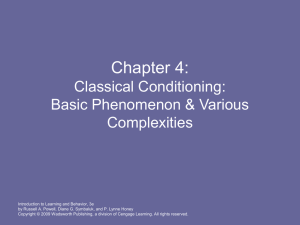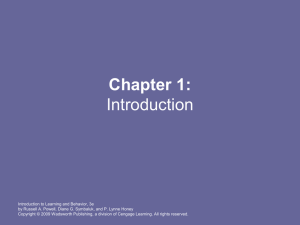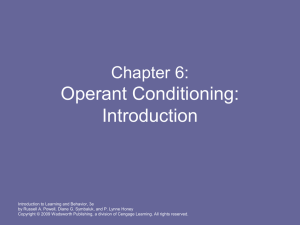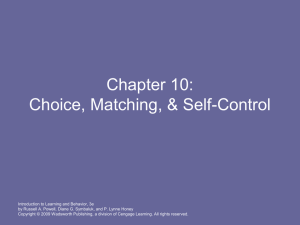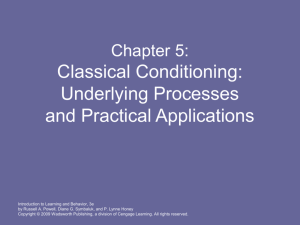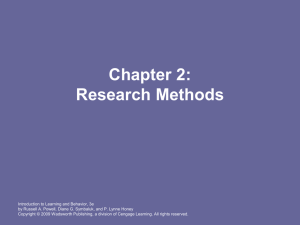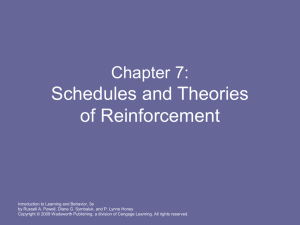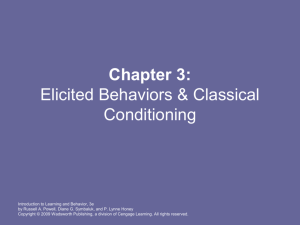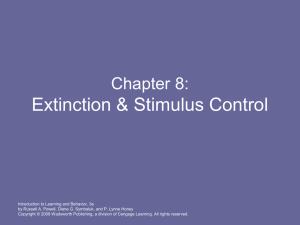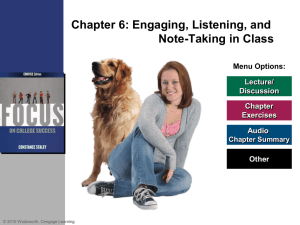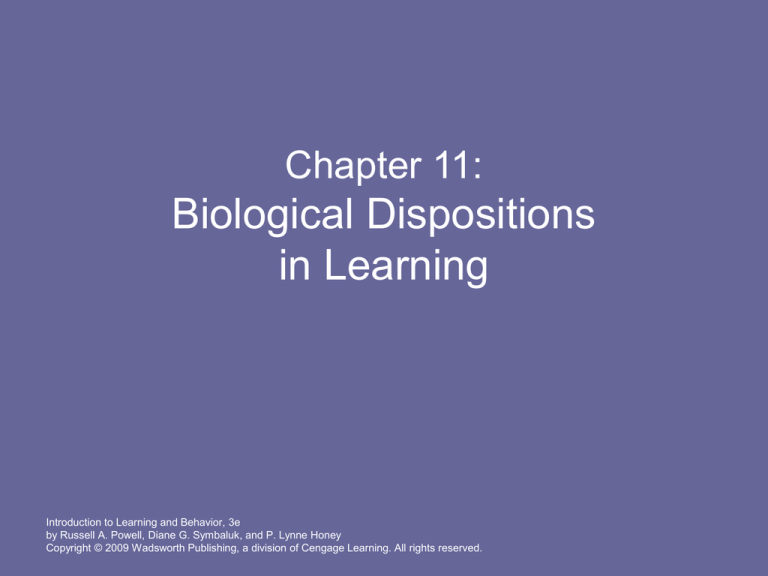
Chapter 11:
Biological Dispositions
in Learning
Introduction to Learning and Behavior, 3e
by Russell A. Powell, Diane G. Symbaluk, and P. Lynne Honey
Copyright © 2009 Wadsworth Publishing, a division of Cengage Learning. All rights reserved.
Preparedness & Classical
Conditioning
• innate tendency for an organism to more
easily learn certain types of behaviors or
to associate certain types of events with
each other.
• Examples:
– Fear conditioning
– Taste Aversion Conditioning
Introduction to Learning and Behavior, 3e
by Russell A. Powell, Diane G. Symbaluk, and P. Lynne Honey
Copyright © 2009 Wadsworth Publishing, a division of Cengage Learning. All rights reserved.
Taste Aversion Conditioning
• a form of classical conditioning in which a food
item that has been paired with gastrointestinal
illness becomes a conditioned aversive stimulus.
• An animal that becomes sick after ingesting a
food item associates the food with the illness
and subsequently finds it distasteful.
• Examples:
– Too much alcohol
– Rat experiments
Introduction to Learning and Behavior, 3e
by Russell A. Powell, Diane G. Symbaluk, and P. Lynne Honey
Copyright © 2009 Wadsworth Publishing, a division of Cengage Learning. All rights reserved.
Experiments with Rats on Taste
Aversion Conditioning
Sweet water: X-ray irradiation Nausea
NS
US
UR
Sweet water Nausea (avoidance of water)
CS
CR
• The sweet water has become an aversive
conditioned stimulus (CS) through its association
with illness.
Introduction to Learning and Behavior, 3e
by Russell A. Powell, Diane G. Symbaluk, and P. Lynne Honey
Copyright © 2009 Wadsworth Publishing, a division of Cengage Learning. All rights reserved.
Stimulus Generalization
• The food items that taste similar to the
aversive item are also perceived as
aversive.
• Example:
– A conditioned aversion to one type of fish
might generalize to other types of fish.
Introduction to Learning and Behavior, 3e
by Russell A. Powell, Diane G. Symbaluk, and P. Lynne Honey
Copyright © 2009 Wadsworth Publishing, a division of Cengage Learning. All rights reserved.
Extinction
• if the aversive food item is repeatedly
ingested without further illness, the CS
(food) may no longer elicit an avoidance
response.
• Example:
– Drinking alcohol again after it made you sick.
Introduction to Learning and Behavior, 3e
by Russell A. Powell, Diane G. Symbaluk, and P. Lynne Honey
Copyright © 2009 Wadsworth Publishing, a division of Cengage Learning. All rights reserved.
Overshadowing
• We are more likely to develop an aversion
to a stronger-tasting food item than to a
milder-tasting item that was consumed at
the same meal.
• Example:
– Onions or potatoes
Introduction to Learning and Behavior, 3e
by Russell A. Powell, Diane G. Symbaluk, and P. Lynne Honey
Copyright © 2009 Wadsworth Publishing, a division of Cengage Learning. All rights reserved.
Blocking
• Example:
– If you have already acquired a taste aversion
to peas, but force yourself to eat them
anyway,
– and then get sick because of some spoiled
fish that was served at the same meal,
– you will not develop an aversion to the fish.
– The presence of the peas will block any
conditioning occurring to the fish.
Introduction to Learning and Behavior, 3e
by Russell A. Powell, Diane G. Symbaluk, and P. Lynne Honey
Copyright © 2009 Wadsworth Publishing, a division of Cengage Learning. All rights reserved.
Latent Inhibition
• We are more likely to associate a relatively novel
item, with sickness than we would a more
familiar item.
• Example:
– Latent inhibition helps explain why it is often difficult to
poison a rat.
– When a rat encounters a novel food item, it will most
likely eat only a small amount of the item before
moving on to other, more familiar items.
– If the rat later becomes ill, it will associate the illness
with the novel item.
Introduction to Learning and Behavior, 3e
by Russell A. Powell, Diane G. Symbaluk, and P. Lynne Honey
Copyright © 2009 Wadsworth Publishing, a division of Cengage Learning. All rights reserved.
Taste Aversion Conditioning is
Different from Other Conditioning
• The formation of associations over long
delays.
– By contrast, most classical conditioning
requires close temporal proximity.
• One-trial conditioning.
– By contrast, most classical conditioning
requires several pairings of the us and cs.
• Specificity of associations.
Introduction to Learning and Behavior, 3e
by Russell A. Powell, Diane G. Symbaluk, and P. Lynne Honey
Copyright © 2009 Wadsworth Publishing, a division of Cengage Learning. All rights reserved.
CS-US Relevance
• an innate tendency to more readily associate
certain types of stimuli with each other.
• Example:
– From the “bright, noisy, sweet water” experiment, we
learned rats have a predisposition:
• to readily associate nausea with taste and
• tactually painful events with visual and auditory
stimuli.
Introduction to Learning and Behavior, 3e
by Russell A. Powell, Diane G. Symbaluk, and P. Lynne Honey
Copyright © 2009 Wadsworth Publishing, a division of Cengage Learning. All rights reserved.
Quail-Rat Experiment
• Both quail and rats drank dark blue, sour-tasting
water before being made ill.
• The rats avoided the sour-tasting water and
strongly preferred the dark blue water.
• They associated the taste of the water with the
nausea.
• The quail were more likely to avoid the dark blue
water than the sour-tasting water.
• They are daytime feeders and rely heavily on
vision for identifying food.
Introduction to Learning and Behavior, 3e
by Russell A. Powell, Diane G. Symbaluk, and P. Lynne Honey
Copyright © 2009 Wadsworth Publishing, a division of Cengage Learning. All rights reserved.
Sex Differences
• Females are better than males at detecting
odors and discriminating among odors.
• Women are more reactive to odors associated
with the experience of nausea.
• Women are more prone to developing taste
aversions.
• Most women report that their sense of smell and
taste is enhanced during the early stages of
pregnancy.
Introduction to Learning and Behavior, 3e
by Russell A. Powell, Diane G. Symbaluk, and P. Lynne Honey
Copyright © 2009 Wadsworth Publishing, a division of Cengage Learning. All rights reserved.
Practical Applications
• Because cancer patients often suffer from
severe weight loss anyway, the
development of taste aversions that lead
to avoidance of certain food items could
be serious.
• We’ve learned to serve meals that consist
of highly familiar foods regularly and to
serve a highly novel, yet trivial, food item
just before a chemotherapy session.
Introduction to Learning and Behavior, 3e
by Russell A. Powell, Diane G. Symbaluk, and P. Lynne Honey
Copyright © 2009 Wadsworth Publishing, a division of Cengage Learning. All rights reserved.
Preparedness & Operant
Conditioning
• Chaffinches seem to be biologically
prepared to associate
– perching in a certain spot with the
consequence of hearing songs, and
– pecking with the consequence of obtaining
food.
• Rats will readily learn to
– press a lever to obtain food pellets, and
– freeze or run to avoid shock.
Introduction to Learning and Behavior, 3e
by Russell A. Powell, Diane G. Symbaluk, and P. Lynne Honey
Copyright © 2009 Wadsworth Publishing, a division of Cengage Learning. All rights reserved.
Species-Specific Defense Reaction
(SSDR)
• avoidance responses elicited by aversive
stimulus.
• Example:
– For rats, running and freezing are behaviors
are naturally elicited in dangerous situations.
– A rat’s tendency to freeze is so strong that it
will sometimes freeze even when doing so
results in shock rather than avoids shock.
Introduction to Learning and Behavior, 3e
by Russell A. Powell, Diane G. Symbaluk, and P. Lynne Honey
Copyright © 2009 Wadsworth Publishing, a division of Cengage Learning. All rights reserved.
Instinctive Drift
• an instance of classical conditioning in
which a genetically based, fixed action
pattern gradually emerges and displaces
the behavior that is being operantly
conditioned.
• Example:
– Skinner’s students tried to train animals to
perform unusual behaviors for television
commercials and movies.
Introduction to Learning and Behavior, 3e
by Russell A. Powell, Diane G. Symbaluk, and P. Lynne Honey
Copyright © 2009 Wadsworth Publishing, a division of Cengage Learning. All rights reserved.
Unusual Results
• They tried to train a pig to deposit a wooden coin in a
piggy bank.
Coin: Deposit coin in bank Food
SD
R
SR
• After some training, the pig started tossing the coin in the
air and then rooting at it on the ground.
Coin: Food Rooting
NS US
UR
Coin Rooting
CS
CR
Introduction to Learning and Behavior, 3e
by Russell A. Powell, Diane G. Symbaluk, and P. Lynne Honey
Copyright © 2009 Wadsworth Publishing, a division of Cengage Learning. All rights reserved.
Sign Tracking
• an organism approaches a stimulus that
signals the presentation of an appetitive
event.
• Example:
– One of Pavlov’s dogs, during a classical
conditioning experiment, approached a light
that had signaled the delivery of food and
licked it.
Introduction to Learning and Behavior, 3e
by Russell A. Powell, Diane G. Symbaluk, and P. Lynne Honey
Copyright © 2009 Wadsworth Publishing, a division of Cengage Learning. All rights reserved.
Sign Tracking Visual
Introduction to Learning and Behavior, 3e
by Russell A. Powell, Diane G. Symbaluk, and P. Lynne Honey
Copyright © 2009 Wadsworth Publishing, a division of Cengage Learning. All rights reserved.
Sign Tracking in Pigeons
Key light: Food Peck
NS
US
UR
Key light Peck
CS
CR
Introduction to Learning and Behavior, 3e
by Russell A. Powell, Diane G. Symbaluk, and P. Lynne Honey
Copyright © 2009 Wadsworth Publishing, a division of Cengage Learning. All rights reserved.
Autoshaping
• a type of sign tracking in which a pigeon comes
to automatically peck at a key.
• The key light has been associated with the
response-independent delivery of food.
• Later the food can then be made contingent
upon pecking.
Key light: Peck Food
SD
R
SR
Introduction to Learning and Behavior, 3e
by Russell A. Powell, Diane G. Symbaluk, and P. Lynne Honey
Copyright © 2009 Wadsworth Publishing, a division of Cengage Learning. All rights reserved.
Pavlov’s
Stimulus-Substitution Theory
• Because of its association with food, the
key light appears to become a substitute
for food.
• The bird attempts to consume it.
• When the bird pecked the key associated
with water and food, it did so with the
standard patterns of behavior when
pigeons drink water and eat food.
Introduction to Learning and Behavior, 3e
by Russell A. Powell, Diane G. Symbaluk, and P. Lynne Honey
Copyright © 2009 Wadsworth Publishing, a division of Cengage Learning. All rights reserved.
Negative Automaintenance
• Sign tracking persists despite the resultant loss
of a reinforcer.
• Example:
– Although the contingency requires the pigeons to
refrain from pecking to actually obtain the food, they
will nevertheless compulsively peck at the key.
– They should simply wait for the food when the key
light appears, but they can’t help themselves.
Introduction to Learning and Behavior, 3e
by Russell A. Powell, Diane G. Symbaluk, and P. Lynne Honey
Copyright © 2009 Wadsworth Publishing, a division of Cengage Learning. All rights reserved.
Adjunctive Behavior
• an excessive pattern of behavior that emerges
as a by-product of an intermittent schedule of
reinforcement for some other behavior.
• As one behavior is being strengthened through
intermittent reinforcement, another quite different
behavior emerges as a side effect of that
procedure.
• It is also called schedule-induced behavior.
Introduction to Learning and Behavior, 3e
by Russell A. Powell, Diane G. Symbaluk, and P. Lynne Honey
Copyright © 2009 Wadsworth Publishing, a division of Cengage Learning. All rights reserved.
Distinguishing Features of
Adjunctive Behavior
• It typically occurs in the period immediately
following consumption of an intermittent
reinforcer.
• It is affected by the level of deprivation for the
scheduled reinforcer.
• It can function as reinforcers for other behaviors.
• There is an optimal interval between reinforcers
for the development of adjunctive behavior.
Introduction to Learning and Behavior, 3e
by Russell A. Powell, Diane G. Symbaluk, and P. Lynne Honey
Copyright © 2009 Wadsworth Publishing, a division of Cengage Learning. All rights reserved.
Examples
• When rats were trained to press a lever for food
on an intermittent schedule of reinforcement,
they also began drinking excessive amounts of
water.
• This pattern of excessive drinking—called
schedule-induced polydipsia developed quite
rapidly.
• It is also possible in other species, including
mice, pigeons, and chimpanzees.
• Pigeons can develop schedule-induced
aggression.
Introduction to Learning and Behavior, 3e
by Russell A. Powell, Diane G. Symbaluk, and P. Lynne Honey
Copyright © 2009 Wadsworth Publishing, a division of Cengage Learning. All rights reserved.
Interreinforcement Intervals
• On fixed time (FT) and fixed interval (FI)
schedules, the delivery of each reinforcer
is followed by a period of time during
which another reinforcer is not available.
• Example:
– The rat usually drinks during the
postreinforcement pause.
Introduction to Learning and Behavior, 3e
by Russell A. Powell, Diane G. Symbaluk, and P. Lynne Honey
Copyright © 2009 Wadsworth Publishing, a division of Cengage Learning. All rights reserved.
Adjunctive Behaviors in Humans
• Human subjects exposed to FI schedules
of monetary reinforcement for game
playing displayed an increased tendency
to drink water following each reinforcer.
• Adjunctive processes may encourage an
individual to frequently consume an
addictive substance.
Introduction to Learning and Behavior, 3e
by Russell A. Powell, Diane G. Symbaluk, and P. Lynne Honey
Copyright © 2009 Wadsworth Publishing, a division of Cengage Learning. All rights reserved.
Displacement Activity
• an apparently irrelevant activity sometimes
displayed by animals when confronted by
conflict or thwarted from attaining a goal.
• It may be used to release pent-up energy.
• It may provide for a more diversified range of
behaviors in a particular setting, and a diverse
range of behavior is often beneficial.
• It may help the animal remain in a situation
where a significant reinforcer might eventually
become available.
Introduction to Learning and Behavior, 3e
by Russell A. Powell, Diane G. Symbaluk, and P. Lynne Honey
Copyright © 2009 Wadsworth Publishing, a division of Cengage Learning. All rights reserved.
Example
• A bird that has a tendency to peck at twigs while
waiting for an insect to emerge.
• It might be releasing nervous energy.
• It might uncover another source of food or a twig
to use as a tool for rooting out the insect.
• It might be just doing something while waiting for
an insect to emerge from its hiding place.
Introduction to Learning and Behavior, 3e
by Russell A. Powell, Diane G. Symbaluk, and P. Lynne Honey
Copyright © 2009 Wadsworth Publishing, a division of Cengage Learning. All rights reserved.
Is it a lack of self-control?
• Smoking is an impulsive behavior in terms of
providing short-term pleasure at the risk of
undermining one’s long-term health
• However, it can also enhance self-control,
helping an individual work long hours so as to
obtain a promotion.
• Quitting smoking not only results in the
temporary onset of withdrawal symptoms.
• It also undermines the person’s ability to work
for long periods of time.
Introduction to Learning and Behavior, 3e
by Russell A. Powell, Diane G. Symbaluk, and P. Lynne Honey
Copyright © 2009 Wadsworth Publishing, a division of Cengage Learning. All rights reserved.
Activity Anorexia
• an abnormally high level of activity and low
level of food intake generated by exposure
to a restricted schedule of feeding.
• Examples:
– When given restrictive access to food, rats will
run in a wheel for several seconds during the
interval between reinforcers.
– The more they run, the less they eat, and the
less they eat, the more they run.
Introduction to Learning and Behavior, 3e
by Russell A. Powell, Diane G. Symbaluk, and P. Lynne Honey
Copyright © 2009 Wadsworth Publishing, a division of Cengage Learning. All rights reserved.
Anorexia Nervosa
• a psychiatric disorder in which patients refuse to
eat adequate amounts of food and as a result
lose extreme amounts of weight.
• It is similar to activity anorexia:
–
–
–
–
It begins with a restricted schedule of feeding.
It is often accompanied by high levels of activity.
It is most common with adolescents.
They remain quite interested in food.
Introduction to Learning and Behavior, 3e
by Russell A. Powell, Diane G. Symbaluk, and P. Lynne Honey
Copyright © 2009 Wadsworth Publishing, a division of Cengage Learning. All rights reserved.
There are differences too.
• The anorexic human is on a self-imposed
diet with food still freely available.
• Anorexia in humans is often accompanied
by bulimia.
Introduction to Learning and Behavior, 3e
by Russell A. Powell, Diane G. Symbaluk, and P. Lynne Honey
Copyright © 2009 Wadsworth Publishing, a division of Cengage Learning. All rights reserved.
What underlies Activity Anorexia?
• Endorphins have been implicated in the feeling
of pleasure that sometimes accompanies
prolonged exercise,
• Drugs that block the effect of endorphins will
temporarily lower the rate of activity.
• Activity anorexia in rats and anorexia nervosa in
humans may be maintained by an addiction to
an endorphin high.
• There also may be a survival value for animals
too – if food is not available, keep moving until
you find some.
Introduction to Learning and Behavior, 3e
by Russell A. Powell, Diane G. Symbaluk, and P. Lynne Honey
Copyright © 2009 Wadsworth Publishing, a division of Cengage Learning. All rights reserved.
Clinical Implications
• Behavioral treatments for anorexia
nervosa should focus as much on
– establishing normal patterns of activity as on
– establishing normal patterns of eating.
• Research into the biochemistry could
facilitate the development of drugs for
treating anorexia.
Introduction to Learning and Behavior, 3e
by Russell A. Powell, Diane G. Symbaluk, and P. Lynne Honey
Copyright © 2009 Wadsworth Publishing, a division of Cengage Learning. All rights reserved.
Prevention
• Warn people that combining a stringent exercise
program with severe dieting places them at risk
for developing anorexia nervosa.
• People who are dieting should eat several small
meals per day as opposed to a single large
meal.
• People who are attempting to increase their
exercise levels should do so slowly.
• Dieters should ensure that their meals are well
balanced nutritionally.
Introduction to Learning and Behavior, 3e
by Russell A. Powell, Diane G. Symbaluk, and P. Lynne Honey
Copyright © 2009 Wadsworth Publishing, a division of Cengage Learning. All rights reserved.
Behavior Systems Theory
• An animal’s behavior is organized into various
motivational systems, such as feeding, mating,
avoiding predators, and so forth.
• Each of these systems encompasses a set of
relevant responses, each of which, in turn, can
be activated by particular cues.
• Different systems may also overlap such that a
response that is typically associated with one
system may sometimes be instigated by another
system.
Introduction to Learning and Behavior, 3e
by Russell A. Powell, Diane G. Symbaluk, and P. Lynne Honey
Copyright © 2009 Wadsworth Publishing, a division of Cengage Learning. All rights reserved.
Example
• When a rat is hungry, it becomes
predisposed to engage in various foodrelated responses, such as
– salivating,
– chewing,
– food handling, and
– searching for food.
• Which response is actually set in motion
will depend on the situation.
Introduction to Learning and Behavior, 3e
by Russell A. Powell, Diane G. Symbaluk, and P. Lynne Honey
Copyright © 2009 Wadsworth Publishing, a division of Cengage Learning. All rights reserved.
Favorite Methods for Studying Rats
• Rats are great at running through mazes
because they have evolved to run along
narrow, enclosed to find food.
• Rats have evolved dexterous forepaws
that they use to pick up food and
manipulate it, so lever pressing is a great
method.
Introduction to Learning and Behavior, 3e
by Russell A. Powell, Diane G. Symbaluk, and P. Lynne Honey
Copyright © 2009 Wadsworth Publishing, a division of Cengage Learning. All rights reserved.
Environmental Cues
• Rats have evolved to pay close attention
to what other rats are eating and will even
steal food from the mouths of other rats.
• Thus, a stimulus rat able to predict the
delivery of food elicited this social
component of the feeding system in the
participant rat.
Introduction to Learning and Behavior, 3e
by Russell A. Powell, Diane G. Symbaluk, and P. Lynne Honey
Copyright © 2009 Wadsworth Publishing, a division of Cengage Learning. All rights reserved.
Environmental Cues Visual
Introduction to Learning and Behavior, 3e
by Russell A. Powell, Diane G. Symbaluk, and P. Lynne Honey
Copyright © 2009 Wadsworth Publishing, a division of Cengage Learning. All rights reserved.
An Animal’s Innate Tendencies
• We need to pay attention to an animal’s
innate tendencies when attempting to
modify its behavior.
• Examples:
– The dog habitually nips at your hand when
you attempt to touch its food.
– The dog has assumed a position of
dominance within the household.
Introduction to Learning and Behavior, 3e
by Russell A. Powell, Diane G. Symbaluk, and P. Lynne Honey
Copyright © 2009 Wadsworth Publishing, a division of Cengage Learning. All rights reserved.
Summary
• Animals appear to be biologically prepared to
learn some things more readily than others.
• In taste aversion conditioning, a food item that
has been paired with nausea quickly becomes
conditioned as an aversive CS.
• It differs from other forms of classical
conditioning in that
– strong associations can be formed over long delays,
– it requires only a single conditioning trial, and
– the nauseas is specifically associated with a food
item.
Introduction to Learning and Behavior, 3e
by Russell A. Powell, Diane G. Symbaluk, and P. Lynne Honey
Copyright © 2009 Wadsworth Publishing, a division of Cengage Learning. All rights reserved.
Summary, continued
• Preparedness can also be seen in operant
conditioning.
– Example: chaffinches and rats
• Adjunctive behavior is an excessive
pattern of behavior that emerges as a byproduct of an intermittent schedule of
reinforcement.
– Example: schedule-induced polydipsia
Introduction to Learning and Behavior, 3e
by Russell A. Powell, Diane G. Symbaluk, and P. Lynne Honey
Copyright © 2009 Wadsworth Publishing, a division of Cengage Learning. All rights reserved.
Summary, continued
• Adjunctive behavior typically
– occurs in the period immediately following the delivery
of the scheduled reinforcer,
– varies directly with the level of deprivation for the
scheduled reinforcer,
– can function as a reinforcer for another behavior, and
– is most likely to occur when the interreinforcement
interval is a few minutes in length.
• It may be a type of displacement activity.
Introduction to Learning and Behavior, 3e
by Russell A. Powell, Diane G. Symbaluk, and P. Lynne Honey
Copyright © 2009 Wadsworth Publishing, a division of Cengage Learning. All rights reserved.
Summary, continued
• Activity anorexia is a pattern of excessive activity
and low food intake in animals as a result of
exposure to a restricted food supply.
• It bears many similarities to certain forms of
anorexia nervosa in humans.
• According to behavior systems theory, an
animal’s behavior is organized into several
motivational systems, each with a set of relevant
responses activated by situational cues.
• This theory accounts for many of the unusual
behavior patterns.
Introduction to Learning and Behavior, 3e
by Russell A. Powell, Diane G. Symbaluk, and P. Lynne Honey
Copyright © 2009 Wadsworth Publishing, a division of Cengage Learning. All rights reserved.

